Bantu peoples in South Africa
The Indigenous and Black people of South Africa were at times officially called Bantu (Afrikaans: Bantoe) by the Apartheid regime. The term Bantu is derived from the word for "people" common to many of the Bantu languages. The Oxford Dictionary of South African English describes its contemporary usage in a racial context as "obsolescent and offensive" because of its strong association with white minority rule and their apartheid system. However, Bantu is used without pejorative connotations in other parts of Africa and is still used in South Africa as the group term for the languages South Africans speak.
| Total population | |
|---|---|
| ~43.872 million (75% of | |
| Languages | |
| Official South African indigenous languages:
Other language(s):
| |
| Religion | |
| Related ethnic groups | |
|
History
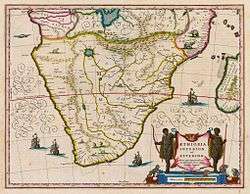
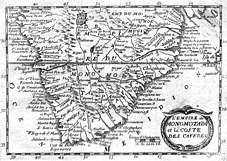
The understanding of history relating to Bantu-speaking peoples from South Africa has in the past been significantly affected by the deliberate spreading of false narratives such as The Empty Land Myth.[3] First published in a book by W.A. Holden in the 1860s, it claims Europeans and the Bantu-speaking peoples had entered South Africa at roughly the same time and that up until that point South Africa had mostly been an ‘empty land’ and that Bantu-speaking peoples had begun to migrate southwards from present day Zimbabwe at the same time as the Europeans had begun to migrate northwards from the Cape settlement, despite there being no historical or archaeological evidence to support this theory.
The theory itself had been circulating in the colony for a long time propagated by European settlers, myths of empty and vacant land were common currency by the mid 1840s. A later alternative form of the same myth was built around the British people and European Afrikaners/Boer understandings of the Mfecane. Using the Mfecane they alleged the land they were occupying had been deserted, this has been found to be deception.[4] By the 1860s, when Holden propagated his theory, this turbulent period had resulted in large swathes of South African land falling under the dominion of either the Boer Republics or British colonials, there was denaturalization accompanied with forced displacement and population transfer of these indigenous peoples from their land, the myth being used as the justification for the capture and settlement of Bantu-speaking peoples's land. The British colonial administrations in the 19th century and subsequent South African governments established rural reserves in 1913 and 1936, by legislating the reduction and voiding of South African Bantu-speaking peoples's land heritage holistically, thereby land relating to Bantu-speaking peoples of South Africa became reduced into being those reserves. More incentive for colonials was also brought about separating Europeans from Africans. In the hands of the Apartheid government the myth became even more destructive, the Apartheid government became the profundity action from the 19th-century British colonial administrations and South African governments before 1948, it introduced a series of measures that reshaped the South African society such that Europeans would take themselves as the demographic majority while being a minority group. The creation of false homelands or bantustans (based on dividing South African Bantu language speaking peoples by ethnicity) was a central element of this strategy, as the long-term goal was to make the bantustans nominally independent, such would result to South African Bantu language speaking peoples losing their citizenship. The bantustan originally reflected an analogy to the various ethnic "-stans" of Western and Central Asia such as the Kafiristan, Pakistan, etc. But in South Africa, the association with Apartheid discredited the term, and the Apartheid government shifted to the politically appealing but historically deceptive term "ethnic homelands". Meanwhile, the Anti-Apartheid Movement persisted in calling the areas bantustans, to drive home the Apartheid governments' political illegitimacy. The fallacy of The Empty Land Myth also completely omits the existence of the Khoisan (a catch-all term) populations of southern Africa who roamed much of the south western region of South Africa for millennia before any arrival of Europeans in South Africa.
Particularly right-wing nationalists of European descent, maintain that the theory still holds true, despite there being even more historical and archaeological evidence contrary to the myth, for example the Lydenburg heads,[5] the Bantu-speaking peoples' Kingdom of Mapungubwe (c.1075–c.1220) and Leo Africanus's 1526 CE account of Bantu-speaking peoples of the region. In the early 16th century, explorer Leo Africanus described the Cafri (Kafir's variant) as negroes, and one of five principal population groups in Africa. He identified their geographical heartland as being located in remote Southern Africa, an area which he designated as Cafraria.[6] European cartographers in their 16th and 17th centuries versions of southern African maps, likewise called the southern African region Cafreria. In the late 16th century, Richard Hakluyt, an English writer, in his words describes Cafars and Gawars, translate to infidels and illiterates (not to be confused with slaves called Cafari, the Malagasy people called Cafres and certain inhabitants of Ethiopia known as Cafars), as Bantu-speaking peoples of southern Africa in his work.[7] Historically past names of South Africa in records largely relied upon how European explorers to Africa referred to the indigenous people, in the 16th century the whole coastal region was known in Portuguese cartography as Cafreria, and in French cartography as Coste Des Caffres, which translates to the Coast of Caffres of the south Limpopo River in 1688, "Cafres or Caffres" being a word derived from an Arabic word "Kafir" (meaning "non-believer"). It was also known as the Bantu-speaking peoples' Kingdom of Mutapa (1430–1760) at its peak. During the establishment and the time through out the 18th century Cape Colony, South Africa was referred to as The Country of the Hottentots and Caffria,[8] (Hottentot is a deprecated reference to the Khoisan people of Western Cape, South Africa, while Caffria stemming from Kafir/Kaffir which is now an offensive racial slur to South African Bantu language speaking peoples). Other than Portuguese cartographers calling present-day South Africa's coast Cafreria in the 16th century, another Cafraria dub directly related to the present-day South African region covered the landscape as presented by a Dutch cartographer Willem Blaeu's work, Theatrum Orbis Terrarum (1635). The later derivative Kaffraria (obsolete name) became a reference to only the present day Eastern Cape.
Based on prehistorical archaeological evidence of pastoralism and farming in southern Africa, ancient settlements closest outside the present-day South African border region, related to Bantu language speaking peoples, so far was found in sites located in the southernmost region inside the borders of what is now Mozambique, and dated 354–68 BCE. Findings similarly based on pastoralism and farming within South Africa thus far — is from sites identified in what was the Transvaal (province), they were dated 249–370 CE.[9]
When the early Portuguese sailors Vasco Da Gama and Bartholomew Dias rounded the Cape of Good Hope in the 15th century CE, a number of Bantu language speakers were found living there though the indigenous population around the Cape primarily consisted of Khoisan groups. Following the establishment of the Dutch Cape Colony, European settlers began arriving in Southern Africa in substantial numbers. Around the 1770s, Trekboers from the Cape encountered more Bantu language speakers around the Great Fish River and frictions eventually arose between the two groups. In the late 18th and early 19th centuries, there were two major areas of frictional contact between the white settlers and the Bantu language speakers in Southern Africa. Firstly, as the Boers moved north inland from the Cape they encountered Xhosa, Basotho, and Tswana communities. Secondly attempts at coastal settlement was made by the British in two regions now known as the Eastern Cape[10] and KwaZulu-Natal.[11][12]
Pedi Kingdom
The Pedi polity under King Thulare (c. 1780–1820) was made up of land that stretched from present-day Rustenburg to the lowveld in the west and as far south as the Vaal river. Pedi power was undermined during the Mfecane, by Ndwandwe invaders from the south-east. A period of dislocation followed, after which the polity was re-stabilised under Thulare's son Sekwati.[13]
Sekwati succeeded Thulare as paramount chief of the Pedi in the northern Transvaal (Limpopo) and was frequently in conflict with the Matabele under Mzilikazi, and plundered by the Zulu and the Swazi. Sekwati was also engaged in numerous negotiations and struggles for control over land and labour with the Afrikaans-speaking farmers (Boers) who had since settled in the region.
These disputes over land occurred after the founding of Ohrigstad in 1845, but after the town was incorporated into the Transvaal Republic in 1857 and the Republic of Lydenburg was formed, an agreement was reached that the Steelpoort River was the border between the Pedi and the Republic. The Pedi were well equipped to defend themselves though, as Sekwati and his heir, Sekhukhune I were able to procure firearms, mostly through migrant labour to the Kimberley diamond fields and as far as Port Elizabeth. The Pedi paramountcy's power was also cemented by the fact that chiefs of subordinate villages, or kgoro, take their principal wives from the ruling house. This system of cousin marriage resulted in the perpetuation of marriage links between the ruling house and the subordinate groups, and involved the payment of inflated bohadi or bride wealth, mostly in the form of cattle, to the Maroteng house.
Creation of the Zulu Kingdom
Before the early 19th century the indigenous population composition in KwaZulu-Natal region was primarily by many different, largely Nguni-speaking clans. In 1816, Shaka acceded to the Zulu throne (at that stage the Zulu was merely one of the many clans). Within a relatively short period of time he had conquered his neighbouring clans and had forged the Zulu into the most important ally of the large Mthethwa clan, which was in competition with the Ndwandwe clan for domination of the northern part of modern-day KwaZulu-Natal.

After the death of the Mthethwa king Dingiswayo around 1818, at the hands of Zwide, the king of the Ndwandwe, Shaka assumed leadership of the entire Mthethwa alliance. The alliance under his leadership survived Zwide's first assault at the Battle of Gqokli Hill. Within two years he had defeated Zwide at the Battle of Mhlatuze River and broken up the Ndwandwe alliance, some of whom in turn began a murderous campaign against other Nguni communities, resulting in a mass migration of communities fleeing those who are regarded now as Zulu people too. Historians have postulated this as the cause of the Mfecane, a period of mass migration and war in the Southern African interior in the 19th, however this hypothesis is no longer accepted by most historians. By 1825, Shaka had conquered a huge empire covering a vast area from the sea in the east to the Drakensberg mountains in the west, and from the Pongola River in the north to the Mbashe River in the south, not far from the modern day town of East London.[14] The idea of Mfecane/Difaqane as an internally induced process of black-on-black destruction has been thoroughly disputed by many scholars, notably by Julian Cobbing.[15]
Inception of apartheid
The Apartheid government retained and continued on from 1948 with even more officiation and policing on racial oppression of Bantu-speaking peoples of South Africa for 48 years. Decades before the inception of Apartheid there was a Rand Rebellion uprising in 1922 which eventually became an open rebellion against the state, it was against mining companies whose efforts at the time, due to economic situations, were nullifying irrational oppression of natives in the work place. The pogroms and slogans used in the uprising against blacks by whites articulated that irrationally oppressing Bantu-speaking peoples of South Africa was much more a social movement in European communities in the 20th century South Africa, before ever becoming government in 1948 which happened through a discriminatory vote by only white, minority people in South Africa, that formed a racist, well resourced and a police state of an illegitimate government for nearly 50 years. In the 1930s, this irrational oppression/discrimination was already well supported by propaganda, e.g. the Carnegie Commission of Investigation on the Poor White Question in South Africa, it served as the blueprint of Apartheid.
Democratic dispensation
A non-racial system franchise known as Cape Qualified Franchise was adhered to from year 1853 in the Cape Colony and the early years of the Cape Province which was later gradually restricted, and eventually abolished, under various National Party and United Party governments. It qualified practice of a local system of multi-racial suffrage. The early Cape constitution which later became known as the Cape Liberal tradition.
When the Cape's political system was severely weakened, the movement survived as an increasingly liberal, local opposition against the Apartheid government of the National Party. In the fight against Apartheid, African majority took the lead in the struggle, as effective allies the remaining Cape liberals against the growing National Party, engaged to a degree in collaboration and exchange of ideas with the growing African liberation movements, especially in the early years of the struggle. This is seen through the non-racial values that were successfully propagated by the political ancestors of the African National Congress, and that came to reside at the centre of South Africa's post-Apartheid Constitution.
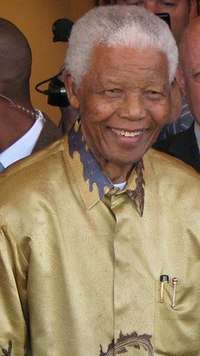
The year 1994 saw the first democratic election in South Africa, the majority of the population, South African Bantu language speaking peoples, participating in political national elections for the first time in what ceremonially ended the Apartheid era and also being the first time a political party in South Africa getting legitimately elected as government. The day was ideally hailed as Freedom day and the beginning of progress to the conclusion of South African Bantu language speaking peoples's existential struggle that began with European colonization in the South African region.
Ethnic partitioning
African — post-Apartheid, used as a population representation in South Africa intends to sum up Black South Africans, and all expatriate Black people from other African countries who are in South Africa — therefore both groupings become single referenced.
South Africa's Bantu language speaking communities are roughly classified into four main groups: Nguni, Sotho–Tswana, Vhavenda and Shangana–Tsonga, with the Nguni being the largest group. These are divided as follows:
- Nguni people:
- Shangana–Tsonga people
- Sotho–Tswana people:
- Venda people:
Culture
Blacks in South Africa were group-related and their conception of borders based on sufficient land and natural features such as rivers or mountains, which were not by any means fixed.
Common among the two powerful divisions, the Nguni and the Sotho–Tswana, are patrilineal societies, in which the leaders formed the socio-political units. Similarly, food acquisition was by pastoralism, agriculture, and hunting. The most important differences are the strongly deviating languages, although both are Southern Bantu languages, and the different settlement types and relationships. In the Nguni settlements villages were usually widely scattered, whereas the Sotho–Tswana often settled in towns.[18]
Language and communication
The majority of Bantu languages spoken in South Africa are classified as belonging to one of two groups. The Nguni languages (such as Xhosa, Zulu, Ndebele, and Swazi), whose speakers historically occupied mainly the eastern coastal plains, and the Sotho–Tswana languages (such as the Southern Sotho, Tswana, Northern Sotho) and whose speakers historically lived on the interior plateau. The two language groups differ in certain key aspects (especially in the sound systems), with the rest of South African Bantu languages (Venda and Tsonga) showing even more unique aspects.[19]Significant number of South African Bantu language speakers are native multilingual, speaking two or more languages as their first language, mainly from languages of South Africa.
Ditema syllabary

A constructed script of featural writing system and syllabary, whose developments in 2010 was inspired by ancient ideographic traditions of the Southern African region, and its parent systems being Amabheqe ideographs and Litema. It was developed for siNtu. The origins of Litema ornamental and mural art of Southern Africa stretches centuries back in time, while excavations at Sotho-Tswana archaeological sites have revealed hut floors that have survived the elements for 1500 years, the earliest intact evidence of this art stretches back from the c. 1400s.
Southern Ndebele paintings
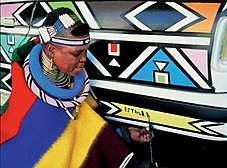
Southern Ndebele prior and during the 18th century primarily used their expressive symbols for communication, it is believed that these paintings are a synthesis of historical Nguni design traditions and Northern Sotho ditema or litema tradition(s). They also began to stand for their continuity and cultural resistance to their circumstances during the colonization in the 19th century. These wall paintings done by the women was their secret code to their people, disguised to anyone but the Southern Ndebele. The vibrant symbols and expressions portray communications of personal prayers, self-identification, values, emotions, and marriage, sometimes the male initiation but the ritual was not expressed. Religions have never been a part of the Southern Ndebele's house paintings. The women of the Southern Ndebele are often the tradition carriers and the main developer of the wall art of their home. The tradition and style of house painting is passed down in the families from generation to generation by the mothers. A well-painted home shows the female of the household is a good wife and mother. She is responsible for the painting of the outside gates, front walls, side walls, and usually the interior of her home. One thing that has changed since the beginning of the paintings and the present-day wall art is their styles. In the late 1960s, the new style was evident, what was once a finger-painted creation was now created using bundled twigs with feathers as brushes. The walls are still originally whitewashed, but the outlines and colours have significantly changed.
The patterns and symbols can be seen today with a rich black outline and a vivid colour inside. There are five main colours represented: red and dark red, yellow to gold, a sky blue, green, and sometimes pink, white is always used as the background because it makes the bright patterns stand out more. The geometric patterns and shape are first drawn with the black outline and later filled in with colour. The patterns are grouped together throughout the walls in terms of their basic design structure. Creating the right tools to allow accuracy and freedom becomes a difficult task. The tools can't restrict the painter from creating her art. They have to have tools for the large geometric shapes of flat colour and small brushes for the very small areas, outlines, and sacks. The advancement of tools has allowed faster and more complex designs throughout the Southern Ndebele's homes. Every generation passes it down and little changes become apparent.
Traditional sports and martial arts
The most popular sporting code in South Africa and among Black South Africans is Association football with the most notable event having been hosted being the 2010 FIFA World Cup, but before such advent there are historical sports that were popular to the indigenous.
Nguni stick-fighting
It is a martial art historically practiced by teenage Nguni herdboys in South Africa. Each combatant is armed with two long, hard sticks, one of which is used for defense and the other for offense with little or no armor used. Although Xhosa styles of fighting may use only two sticks, variations of Bantu/Nguni stick-fighting throughout Southern Africa incorporate shields as part of the stick-fighting weaponry. Zulu stick-fighting uses an isikhwili, an attacking stick, and ubhoko, a defending stick or an ihawu, a defending shield. The objective is for two opposing warriors to fight each other to establish which of them is the strongest or the "Bull" (Inkunzi). An "induna" or War Captain becomes a referee for each group of warriors, keeps his crew in check and keeps order between fighters. Warriors of similar affiliation did this when engaging in combat with one another. In modern times this usually occurs as a friendly symbolic practice part of the wedding ceremony, where warriors (participants) from the bridegroom's household welcome warriors from the bride's household. Other groups of participants may also be welcomed to join in.
Musangwe
A traditional, bare-knuckle, combat sport of Venda people. It resembles bare-knuckle boxing.[20][21]
Chiefdom
It is well documented in the Apartheid legislation, that the white minority, government regime — recreated and used the "traditional" Chiefdom-ships system to be the National Party's power reach, and even increased the Chiefdom-ships' powers over the Bantu-speaking peoples of South Africa for the Apartheid government's interests. This was after colonial regimes and subsequent South African governments before formal Apartheid, had initiated the taking of most of South African land from the indigenous peoples. Most of South African land began being made an exclusive possession of only white minority Europeans in South Africa legislatively by 1913.
Until very recently, South African Bantu-speaking communities were often divided into different clans, not around national federations, but independent groups from some hundreds to thousands of individuals. The smallest unit of the political organizational structure was the household, or kraal, consisting of a man, woman or women, and their children, as well as other relatives living in the same household. The man was the head of the household and often had many wives, and was the family's primary representative. The household and close relations generally played an important role. Households which lived in the same valley or on the same hill in a village were also an organizational unit, managed by a sub-chief.
Chiefdom-ship was largely hereditary, although chiefs were often replaced when not effective. In most clans the eldest son inherited the office of his father. In some clans the office was left to the oldest brother of the deceased chief, and after his death again the next oldest brother. This repeated until the last brother died. Next was the eldest son of the original chieftain; then the oldest one of the brothers as the leader.
The chief was surrounded with a number of trusted friends or advisors, usually relatives like uncles and brothers, rather than influential headmen or personal friends. The degree of the democracy depended on the strength of the chieftain. The more powerful and more influential a chieftain was, the less the influence of his people. Although the leader had much power, he was not above the law. He could be criticized both by advisors as well as by his people, and compensation could be demanded. The people were divided into different clans or tribes which had their own functions, laws, and language.[22]
Time-reliant traditions
.jpg)
Xhosa calendar
Xhosa people historically and traditionally based their agricultural time on reliable star systems. When these traditions are aligned with the Gregorian calendar system the Xhosa year begins in June and ends in May when the Canopus star (in Xhosa: UCanzibe) becomes visible in the Southern hemisphere, this signaled their time for harvesting. Xhosa months are poetically named after stars and seasonal plants of Southern Africa.
Sotho calendar
Sesotho months (in Sotho: Likhoeli) indicate special natural and agricultural events of Southern Africa. Traditionally and historically, being cattle breeders who lived in the semi-arid regions of Southern Africa, a deep understanding of agriculture and the natural world was essential for their survival. Sesotho speaking people generally recognise only two seasons called Dihla. However, names do exist aligned to all four of the traditional Western seasons. The Sotho year begins approximately in August or September, a time when their crops were planted.
Traditional holidays
First Fruits
A ceremony of giving the first fruits in a harvest to God, or the gods who are believed to be responsible for the abundance of food. Traditionally it marked a time of prosperity, in the good harvests experienced after the seasonal agricultural period. It also brought people together, unifying them at a time of merry making and quashing fears of famine. In Southern Africa the tradition is still practiced mainly by Zulu people of KwaZulu-Natal and people of the Kingdom of Eswatini.
Historical food acquisition
Food acquisition was primarily limited to types of subsistence agriculture (slash and burn and Intensive subsistence farming), pastoral farming and engaging in hunting. Generally women were responsible for crop agriculture and men went to herd and hunt except for the Tsonga (and partially the Mpondo). Fishing was relatively of little importance. All Bantu-speaking communities commonly had clear separation between women's and men's tasks.
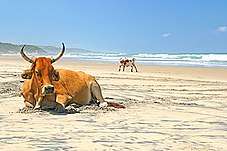
Essentially they consumed meat (primarily from Nguni cattle, Nguni sheep (Zulu sheep, Pedi sheep, Swazi sheep), pigs/boars and wild game hunts), vegetables, fruits, cattle and sheep milk, water, and grain beer on occasion. They began to eat the staple product of maize mid-18th century (introduced from the Americas by Portuguese in the late 17th century via the East African coast), it became favoured for its productiveness which was more than the grains of South African native grasses.[23] There were a number of taboos regarding the consumption of meat. The well known, no meat of dogs, apes, crocodiles or snakes could be eaten. Likewise taboo was the meat of some birds, like owls, crows and vultures, as well as the flesh of certain totem animals. The mopane worms are traditionally popular amongst the Tswana, Venda, Southern Ndebele, Northern Sotho and Tsonga people, though they have been successfully commercialized.
South African Bantu language speaking peoples' modern diet is largely still similar to that of their ancestors, but significant difference being in the systems of production and consumption of their food. They do take interest to innovations in foods that come their way while still practicing their very own unique food cuisine popular amongst themselves and those curious alike.
Pre-colonial and traditional house types
Historically, communities lived in two different types of houses before this tradition was dominated by one, the Rondavel. The Nguni people usually used the beehive house, a circular structure made of long poles covered with grass. The huts of the Sotho–Tswana people, Venda people and Shangana–Tsonga people, used the cone and cylinder house type. A cylindrical wall is formed out of vertical posts, which is sealed with mud and cow dung. The roof built from poles tied-together, covered with grass. The floor of both types is compressed earth.[24]
The Rondavel itself developed from the general, grass domed African-style hut nearly 3 000 years ago, its first variety, the veranda Rondavel, emerged about 1 000 years ago in southern Africa. Colonial housing styles inspired the rectangular shaping of the Rondavel from the 1870s, this is regarded as the beginning of the Rondavel's westernization that sees this African indigenous invention even today being popularly known as the Rondavel, (a derivative of Afrikaans: Rondawel), instead of its indigenous name(s). Constraints caused by urbanisation produced a highveld type of style housing, shack-like, structures coalesced with corrugated metal sheeting (introduced during the British colonization), this marked a significant visible change in the southern African region, it attested to the contemporary pressures of South African Bantu-speaking peoples's realities, especially that of resources.[25]
 Venda people's village of Mbilwe, Rondavels as its structures on a rising slope as photographed in 1923, a decade after the Natives Land Act, 1913[26]
Venda people's village of Mbilwe, Rondavels as its structures on a rising slope as photographed in 1923, a decade after the Natives Land Act, 1913[26]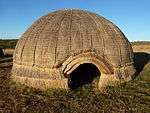 A reconstruction in a heritage site of KwaZulu-Natal of the Zulu people's variation of a hut called iQhungwane, which dominated as an indigenous abode during Dingane kaSenzangakhona's reign.
A reconstruction in a heritage site of KwaZulu-Natal of the Zulu people's variation of a hut called iQhungwane, which dominated as an indigenous abode during Dingane kaSenzangakhona's reign.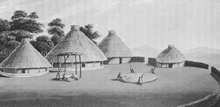 Bahurutshe people's homestead of veranda Rondavels pre-1822 from the ancient city of Kaditshwene (c.1400s–c.1820s).
Bahurutshe people's homestead of veranda Rondavels pre-1822 from the ancient city of Kaditshwene (c.1400s–c.1820s). Early 19th century, South Africa. Bantu-speaking peoples of South Africa's variation of a hut, built on stilts, to protect themselves from lions and other predatory animals.
Early 19th century, South Africa. Bantu-speaking peoples of South Africa's variation of a hut, built on stilts, to protect themselves from lions and other predatory animals.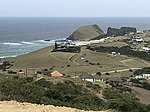 Modern usage of the Rondavel, residency near the coastline of Eastern Cape, South Africa.
Modern usage of the Rondavel, residency near the coastline of Eastern Cape, South Africa.
Ideologies
Umvelinqangi
Umvelinqangi according to mainly Xhosa and Zulu people's culture is the Most High or Divine Consciousness, is the source of all that has been, that is and all that ever will be. It's the inner light of creation. Ukukhothama (similar to meditation) prior to Colonization/Westernization was a widespread practice in South Africa noticeably by those considered Zulu people now, it was seen as a way of attaining oneness (in Zulu: Ubunye), with the divine conscious.
King Shaka's philosophy
King Shaka is well known for the many military, social, cultural and political reforms he used to create his highly organized and centralized Zulu state. The most important of these were the transformation of the army, thanks to innovative tactics and weapons he conceived, and a showdown with the spiritual leadership, limiting the power of traditional healers, and effectively ensuring the subservience of the Zulu church to the state. King Shaka integrated defeated clans into the Zulu, on a basis of full equality, with promotions in the army and civil service being a matter of merit rather than circumstance of birth.[27]
Black Consciousness Movement
An anti-Apartheid movement that emerged in South Africa in the mid-1960s. BCM attacked what they saw as traditional white values, especially the "condescending" values of white people of liberal opinion and emphasised the rejection of white monopoly on truth as a central tenet of their movement. The BCM's policy of perpetually challenging the dialectic of Apartheid South Africa as a means of transforming Black thought into rejecting prevailing opinion or mythology to attain a larger comprehension brought it into direct conflict with the full force of the security apparatus of the Apartheid regime.
Ubuntu philosophy
A concept that began to be popularised in the 1950s and became propagated by political thinkers specifically in Southern Africa during the 1960s. Ubuntu asserts that society, not a transcendent being, gives human beings their humanity. An "extroverted communities" aspect is the most visible part of this ideology. There is sincere warmth with which people treat both strangers and members of the community. This overt display of warmth is not merely aesthetic but enables formation of spontaneous communities. The resultant collaborative work within these spontaneous communities transcends the aesthetic and gives functional significance to the value of warmth. It is also implied that Ubuntu is in the ideal of that everyone has different skills and strengths; people are not isolated, and through mutual support they can help each other to complete themselves.
Notable South African Bantu-speaking people
Notation of notable people from South African-Bantu speaking peoples hosts renowned, contributors, scholars and professionals from a range of diverse and broad fields, also those who are laureates of national and international recognition and certain individuals from South African monarchs. They are also known as Black South Africans.
See also
| Wikimedia Commons has media related to Bantu-speaking peoples of South Africa. |
- Demographics of South Africa
- Khoi—San peoples
- Coloureds
- Asian South African
- White South African
Diaspora
- Northern Ndebele people
- Ngoni people
- Kololo people
- Makololo Chiefs (Malawi)
- (Their modern descendants have little connection with the Kololo people apart from their name.)
- Relating South African diaspora
References
- "Country: South Africa". joshuaproject.net. Retrieved 7 August 2020.
- "Meet the 800-year-old golden rhinoceros that challenged apartheid South Africa". theconversation.com. Retrieved 16 September 2016.
- "The Empty Land Myth". sahistory.org.za.
- Eldredge, Elizabeth A. (2015). Kingdoms and Chiefdoms of Southeastern Africa: Oral Traditions and History, 1400–1830. Boydell & Brewer. p. 324. ISBN 978-1-58046-514-4.
- "Lydenberg Heads (ca.500 A.D.)". www.metmuseum.org.
- Africanus, Leo (1526). The History and Description of Africa. Hakluyt Society. pp. 20, 53 & 65. Retrieved 27 July 2017.
- Works by Richard Hakluyt at Project Gutenberg
- Paterson, Lieut. William (1789). A Narrative of four Journeys into the Country of the Hottentotts and Caffria. In the Years One Thousand Seven Hundred and Seventy-Seven, Eight, and Nine. London: J Johnson.
- Lander, Faye; Russell, Thembi (2018). "The archaeological evidence for the appearance of pastoralism and farming in southern Africa". PLOS ONE. 13 (6): e0198941. Bibcode:2018PLoSO..1398941L. doi:10.1371/journal.pone.0198941.
- Peires, Jeffrey Brian (1976). A History of the Xhosa C. 1700–1835. Grahamstown: Rhodes University.CS1 maint: ref=harv (link)
- Martin Meredith, Diamonds Gold and War, (New York: Public Affairs, 2007):5
- Knight, Ian (2004). Zulu War. Osprey. p. 11.
- "History of the Pedi". southafrica.co.za. Retrieved 9 July 2020.
- Eldredge, Elizabeth A. (2014). The Creation of the Zulu Kingdom, 1815–1828. New York: Cambridge University Press. doi:10.1017/cbo9781139871686. ISBN 978-1-139-87168-6.
- "The Mfecane as Alibi: Thoughts on Dithakong and Mbolompo" (PDF). The Journal of African History, Volume 29, Issue 3, Cambridge University Press. 1988. Retrieved 16 September 2015.
- "Southern Africa". www.britannica.com. Retrieved 8 August 2020.
- "Korana in South Africa". joshuaproject.net. Retrieved 7 August 2020.
- Guthrie M., Comparative Bantu. Farnboroiugh Vols. 1–4., Gregg International Publishers Ltd. 1967
- Guthrie M., Comparative Bantu. Farnboroiugh Vols. 1–4., Gregg International Publishers Ltd. 1967
- Wende, Hamilton (5 February 2011). "South African boxing that 'makes the heart strong'". BBC. Retrieved 6 February 2011.
- Shalati Nkhwashu (21 February 2011). "It's jaw-breaking time as musangwe hits Soweto". Archived from the original on 15 October 2014.
- Guthrie M., Comparative Bantu. Farnboroiugh Vols. 1–4., Gregg International Publishers Ltd. 1967
- Beach, David N. (1983). "The Zimbabwe Plateau and its Peoples". In Birmingham, David; Martin, Phyllis M. (eds.). History of Central Africa, volume 1. London: Longman. pp. 245–277. ISBN 978-0-582-64673-5.
- Guthrie M., Comparative Bantu. Farnboroiugh Vols. 1–4., Gregg International Publishers Ltd. 1967
- Gerald Steyn (2006). The indigenous rondavel – a case for conservation. Architecture, Tshwane University of Technology, South Africa.
- MICHAEL GODBY (2009). Alfred Martin Duggan-Cronin’s Photographs for The Bantu Tribes of South Africa (1928–1954): The Construction of an Ambiguous Idyll 1. Department of Historical Studies, UCT. p. 57.
- Guthrie M., Comparative Bantu. Farnboroiugh Vols. 1–4., Gregg International Publishers Ltd. 1967
Further reading
- Vail, Leroy, editor. The Creation of Tribalism in Southern Africa. London Berkeley: Currey University of California Press, 1989.
- B. Khoza (PHD), Makhosi, author. Uzalo Isizulu Grammar Textbook. Cambridge University Press, 2017.
.jpg)
.jpg)